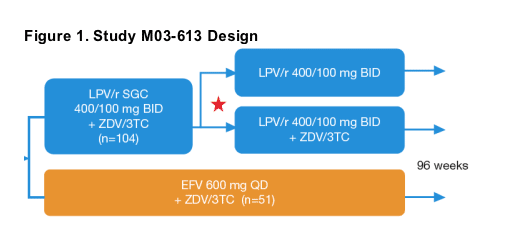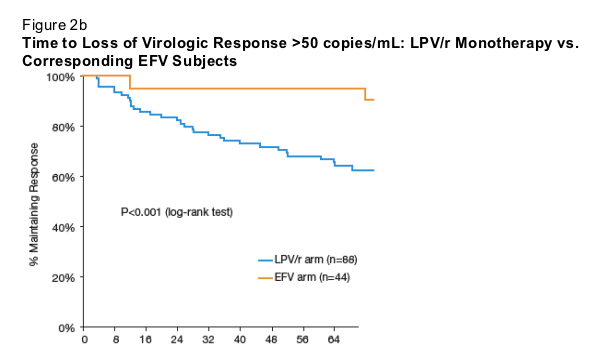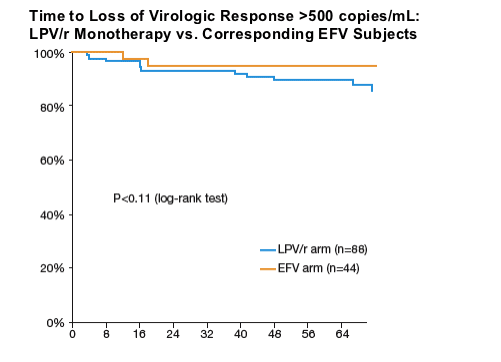 |
 |
 |
| |
Predictors of Loss of Virologic Response in Subjects Who Deintensified to Lopinavir/ritonavir Monotherapy After Achieving Plasma HIV-1 RNA <50 copies/mL on Lopinavir/ritonavir Plus Zidovudine/lamivudine
|
| |
| |
Reported by Jules Levin
CROI, Feb 2007, Los Angeles
R Campo1, BA da Silva2, L Cotte3, J Gathe4, B Gazzard5, C Hicks6, M DeHaan2, KJ Wikstrom2, M King2, GJ Hanna2
1University of Miami School of Medicine, Miami, FL, USA; 2Abbott, Abbott Park, IL, USA; 3Hopital Hotel Dieu, Lyon, France;
4Therapeutic Concepts, Houston, TX, USA; 5Chelsea and Westminster Hospital, London, England; 6Duke University, Durham, NC, USA
".....subjects reporting at least one missed LPV/r dose had a 2.7-fold higher risk of confirmed HIV-1 RNA rebound >50 copies/mL (p=0.01); the risk of virologic rebound decreased 17% for each additional 50 CD4+ Tcells/mm3 at baseline (p=0.01)..... A shorter duration of suppression prior to deintensification to LPV/r monotherapy was associated with a shorter time to virologic rebound in a previous study. However, the design of our study, with a relatively short duration of virologic suppression prior to deintensification, did not allow the investigation of this effect....."
After successful induction treatment with lopinavir/ritonavir (LPV/r) plus zidovudine/lamivudine (ZDV/3TC), LPV/r monotherapy maintained plasma HIV-1 RNA suppression <50 copies/mL in a majority of subjects for up to 72 weeks in Study M03-613. However, subjects receiving LPV/r monotherapy had more frequent confirmed HIV-1 RNA rebound above 50 copies/mL compared to subjects receiving efavirenz (EFV) + ZDV/3TC.1 We sought to determine predictors of confirmed HIV-1 RNA rebound in subjects receiving LPV/r monotherapy.
155 antiretroviral-naive HIV-1 positive subjects were randomized 2:1 to LPV/r + ZDV/3TC induction (n=104) for at least 24 weeks, followed by maintenance LPV/r monotherapy after 3 consecutive monthly plasma HIV-1 RNA levels <50 copies/mL, or to EFV + ZDV/3TC (n=51), as described in figure 1.

Inclusion criteria
- Antiretroviral-naive
- HIV-1 RNA >1000 copies/mL
- Any CD4 count
- No evidence of resistance to study drugs
Deintensification starting at Week 24 if 3 consecutive monthly HIV-1 RNA levels <50 copies/mL
92/104 subjects randomized to LPV/r + ZDV/3TC achieved 3 consecutive HIV-1 RNA levels <50 copies/mL, deintensified to LPV/r monotherapy, and were followed for a median of 68 weeks on monotherapy.
Virologic endpoints included confirmed HIV-1 RNA rebound above 50 or 500 copies/mL. Single "blips" above 50 or 500 copies/mL were considered virologic endpoints if followed by study discontinuation prior to confirmation. Viral resuppression after confirmed virologic rebound was ignored, in order to investigate predictors of confirmed rebound irrespective of subsequent viral outcome.
Potential predictors of response examined in this analysis included demographics, baseline HIV-1 RNA level and CD4+ T-cell count, and adherence by 4-day subject recall. Adherence was categorized as "low" or "high" based on whether subjects did or did not, respectively, report missed doses.
Associations with virologic rebound were assessed using the Cox proportional hazards model with a stepwise selection procedure (p=0.1 to enter and stay in the model).
Four subjects with HIV-1 RNA >50 copies/mL at the time of deintensification were excluded from the analysis.
RESULTS
Most subjects in both treatment groups achieved and maintained virologic response, although those subjects who deintensified to LPV/r monotherapy were more likely to demonstrate confirmed HIV-1 RNA rebound >50 copies/mL (generally between 50 and 500 copies/mL) than EFV-treated subjects (Figures 2a, 2b). At week 96, 60% of LPV/r and 63% of EFV subjects had HIV-1 RNA <50
copies/ml (ITT, NC=F).
Subjects who deintensified to LPV/r monotherapy (n=92) were primarily white (59%) and male (78%), with a mean baseline HIV-1 RNA level of 4.9 log10 copies/mL and a mean baseline CD4+ T-cell count of 226 cells/mm3. Deintensification occurred after a median of 24 weeks on LPV/r + ZDV/3TC, and at a median of 12 weeks after first documented HIV-1 RNA <50 copies/mL.
Average adherence by self-reported 4-day recall for subjects who deintensified to LPV/r monotherapy was 97.4%. Self-reported adherence was statistically significantly correlated with pill count-based adherence assessment (p<0.001).
Among subjects who deintensified to LPV/r monotherapy, 32 had confirmed HIV-1 RNA rebound >50 copies/mL. Although many of these 32 subjects subsquently demonstrated resuppression of HIV-1 RNA <50 copies/mL, the current analysis treats them as nonresponders to investigate predictors of confirmed virologic rebound irrespective of subsequent viral outcome. Twelve (12) of these
32 subjects also demonstrated confirmed HIV-1 RNA rebound >500 copies/mL (Figure 2b).

Weeks Since Switch to Maintenance (LPV/r Arm) or
3rd Consecutive HIV-1 RNA Value <50 copies/mL (EFV Arm)

Weeks Since Switch to Maintenance (LPV/r Arm) or
3rd Consecutive HIV-1 RNA Value <50 copies/mL (EFV Arm)
By multivariable Cox proportional hazards model, subjects reporting at least one missed LPV/r dose had a 2.7-fold higher risk of confirmed HIV-1 RNA rebound >50 copies/mL (p=0.01); the risk of virologic rebound decreased 17% for each additional 50 CD4+ Tcells/mm3 at baseline (p=0.01). Kaplan-Meier estimates of the time to virologic rebound by adherence and baseline CD4+ T-cell count category are displayed in Figure 3.
The median baseline CD4+ T-cell counts in subjects with or without confirmed virologic rebound were 169 vs. 235 cells/mm3, respectively.
Age, race and gender were not significantly associated with HIV-1 RNA rebound, either in univariate analyses or after adjusting for baseline CD4+ T-cell count and adherence (p>0.4 for each variable). Baseline HIV-1 RNA level was marginally associated with HIV-1 RNA rebound by univariate analysis (p=0.08), but not after adjustment for baseline CD4+ T-cell count and adherence (p=0.42).

Both adherence and baseline CD4+ T-cell count were marginally associated with confirmed HIV-1 RNA rebound >500 copies/mL (p=0.07, p=0.06, respectively).
Kaplan-Meier estimates of the time to confirmed virologic rebound >500 copies/mL by adherence and baseline CD4+ T-cell count category are displayed in Figure 4.
DISCUSSION
In our analysis, both self-reported adherence and baseline CD4+ T-cell count were associated with the risk of confirmed virologic rebound among subjects
treated with a LPV/r-based induction/maintenance strategy.
The precise adherence level required to maintain viral suppression with an induction/maintenance regimen cannot be determined from our analysis, since
self-reported adherence is a relatively inexact measure and frequently overestimates the true adherence rate.2,3,4
Previous analyses have suggested LPV/r-based combination therapy is relatively tolerant of modest reductions in adherence.5,6 The findings from the
current study indicate LPV/r monotherapy may be less tolerant to reductions in adherence compared to LPV/r-based combination therapy.
A shorter duration of suppression prior to deintensification to LPV/r monotherapy was associated with a shorter time to virologic rebound in a previous study.7 However, the design of our study, with a relatively short duration of virologic suppression prior to deintensification, did not allow the investigation of this effect.
Conclusions
For subjects maintained on LPV/r monotherapy following successful short-term (median 24 weeks) induction on LPV/r + ZDV/3TC:
Higher levels of adherence to the LPV/r monotherapy regimen were associated with higher likelihood of maintaining suppression of viremia.
Lower baseline CD4+ T-cell counts were associated with lower likelihood of maintaining suppression of viremia.
|
| |
|
 |
 |
|
|